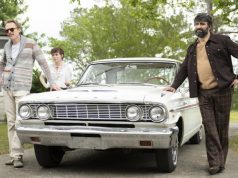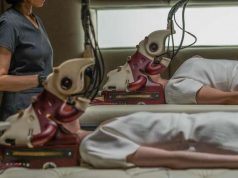Many fine documentaries are made chronicling the rise and fall of rock bands, the tragic character flaws and fantastic excess often making for enjoyable cinema. But “New York Doll” is not one of those films. It is not the story of an influential rock band, but of one of the band’s members — and 30 years after the band broke up. And it’s one of the best documentaries of the year.
The New York Dolls, now known primarily only to rock historians and punk buffs, were THE proto-punk band in the first half of the 1970s. In states of semi-cross-dress and gaudy makeup, the Dolls performed raucous shows of grungy energy and anarchic rock ‘n’ roll. Groups like The Clash, the Sex Pistols and the Smiths cited the Dolls specifically as influences, and countless other groups can trace their DNA to the band, which burned brightly from 1971 to 1975 before flaming out in the usual trainwreck of drugs and jealousy.
The bass player was one Arthur “Killer” Kane, a laconic, highly focused player known for standing stock-still on stage while banging out ferocious bass riffs. During the late ’70s and early ’80s, he bottomed out on drugs, ended his marriage and constantly tried to resurrect his short-lived musical career. In 1989, he saw a TV commercial for the Book of Mormon. In a spirit of “why not?,” he sent for it. But as he put it later, “They don’t send it, they bring it”: Two missionaries arrived on his doorstep. Shortly thereafter, he was baptized, the bass player for one of the most important rock bands in history now a member of The Church of Jesus Christ of Latter-day Saints.
Documentarian Greg Whiteley, also a Mormon, begins the film in 2004, when Arthur is a simple, contented — some might say nerdy — 55-year-old man living in Los Angeles. He takes the bus every day to the Mormon temple, where he volunteers at the Family History Center. He loves his religion and is doted on by the elderly ladies who work alongside him at the genealogy library. He is light years away from the rock star he used to be, and he doesn’t seem to miss it. And yet….
He does miss it, of course, or at least parts of it. He doesn’t drink or smoke anymore, nor indulge in many of the other trappings of the rock-star lifestyle, but he still loves the music. He wishes the experience had lasted longer before it imploded.
As he has done for so many of us, Morrissey comes to the rescue. The former lead singer of the Smiths and one-time president of the New York Dolls Fan Club is putting together a London concert called the Meltdown Festival. He says he wants nothing more than for the New York Dolls to reunite on his stage.
Arthur is thrilled. Only three of the original six band members are still alive, but they are the main ones — Arthur, lead singer David Johansen and guitarist Sylvain Sylvain. The three have not spoken in years, and in fact Arthur and David are technically still feuding. Differences must be put aside. And above all, the Dolls must learn to play together again, and to play well, to overcome the very strong possibility that the reunion will be an embarrassing disaster.
I won’t tell you what happens at the concert, or what happens when Arthur must thereafter return to his ordinary, unglamorous life. Devotees of this sort of thing might already know from reading about it when it happened, but I suspect most people do not, and I want you to enjoy the surprises unspoiled.
Like all great documentaries that focus on one person, “New York Doll” benefits from a central figure who is immediately likable. This uncool, dotty man, who marvels at the fine accommodations in his London hotel room, who (badly) plays Mormon hymns on the harmonica for his friends, who had to pawn his guitars to pay his bills — this man’s heart is completely pure, his intentions innocent. His most important reason for playing the Meltdown Festival is not to regain fame and glory, but to make amends with David and to be with friends again. The applause is nice, but he just likes playing the bass with his buddies. You want this guy to get everything he ever desired, and his guileless attitude toward life makes you want to protect him while he attempts it.
The result is a straightforward rockumentary that is as heartwarming as it is rockin’. Whiteley’s warmth for his subject comes through without reducing his objectivity. He knows he doesn’t have to stack the deck to make us love Arthur “Killer” Kane. All he has to do is show him to us.
A- (1 hr., 17 min.; )





